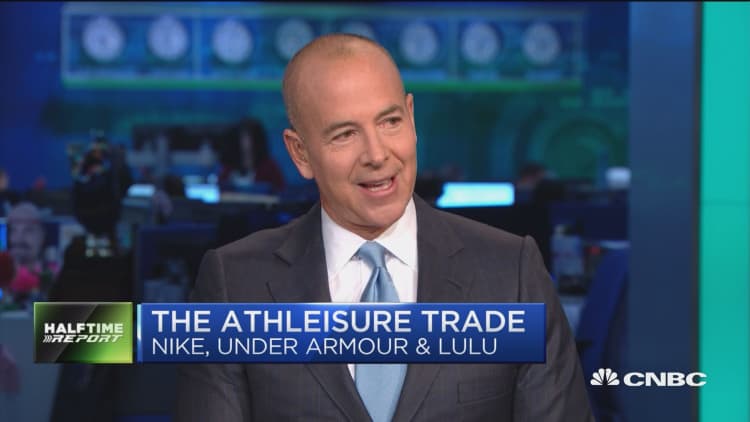
Squabbling Nike analysts will finally know how the company held up against a tougher group of competitors, excess inventories in the athletic wear space, and a slowdown in sales of basketball shoes when it reports fiscal fourth-quarter earnings Tuesday.
Yet following the U.K. vote to exit the European Union, a new set of questions is arising around the company's business — namely, how big a dent the Brexit may have on its revenues and profits.
As one of its largest markets, Nike's U.K. business accounts for roughly 5 percent of its total revenues, according to analysts' estimates. While still relatively small, that exposure makes it one of the most heavily reliant on the region. When widening the lens to include all of Europe, the continent accounts for roughly a quarter of Nike's sales — meaning continued weakness in the pound and euro could put downward pressure on its earnings.
Swings in European currencies have already reduced Nike's earnings by 5 percent over the past year and a half, according to research by Credit Suisse. The pound fell to a 31-year low versus the U.S. dollar on Monday, while the euro also dropped. But currency fluctuations aren't the only risk.
"The biggest risk to earnings is the potential demand shock across broader European markets given likely instability in the region over the next nine months," Credit Suisse analyst Christian Buss said of the overall apparel and footwear space. "This adds incremental risk to a sector already showing clear signs of top-line deceleration in the North American market, while still suffering from unfavorable currency swings."
Indeed, a stronger U.S. dollar has already taken a bite out of Nike's European business. During the third quarter, revenue in Western Europe rose 12 percent on a constant currency basis; that growth was reduced to just 2 percent when accounting for the role of currencies.
Foreign exchange headwinds played a similar role on the company's future orders, which refer to those placed by wholesale customers that were not delivered during the period. While future orders grew by 16 percent in Western Europe during the quarter, they would have risen 23 percent excluding the impact of currencies.
"At this point, the FX headwind created by a weaker [pound], coupled with shaky consumer sentiment and potential to curtail spending, factor in as our more tangible near-term concerns," Jefferies analyst Edward Plank told investors. However, he said Nike's underlying popularity in Europe — along with that of the broader athletic wear category — mean the Brexit is unlikely to have a material impact on Nike. That is, at least in the short-term.
"A potentially greater issue is what could transpire if the fallout from Brexit has a bigger impact across the rest of the EU, for which we won't begin to speculate," Plank said. "But suffice to say, if things begin to unravel, then the implications to our [covered stocks] could be significantly greater."
As for the recently ended quarter, analysts are split as to whether Nike, a consistent performer and preferred name on Wall Street, was able to overcome a swath of challenges that threatened to slow its momentum. Among those challenges are recent traction at competitors Lululemon and Adidas, as well as continued growth at Under Armour.
U.S. footwear sales at Adidas, a brand that had lost its "cool" factor with American shoppers, increased 26 percent year-over-year during April and May, according to a recent note by Morgan Stanley. The report also said Under Armour's Stephen Curry shoes had taken roughly 8 percent share from Nike as of June 1. That day, both Morgan Stanley and Bank of America Merrill Lynch downgraded Nike's shares from "overweight" to "equal weight."
Along with increased competition in a crowded sports apparel space, analysts have called out oversupply in the industry, bankruptcies by major chains including Sports Authority, and lower average selling prices as additional headwinds. Analysts are likewise forecasting a slowdown in future orders as a result of excess inventories.
Consensus fourth-quarter estimates for Nike are calling for $8.28 billion in revenue, which would represent a 6 percent increase over the prior year, according to Thompson Reuters. Yet they're also calling for earnings of 48 cents a share, which would represent a decline of 2 percent compared with the prior-year period.
Shares of Nike are down 17 percent so far this year, near $52.


